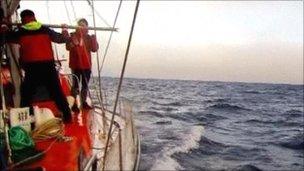Arctic sea routes open as ice melts
- Published

Last year, the Peter 1 yacht sailed around the Arctic using both passages
Two major Arctic shipping routes have opened as summer sea ice melts, European satellites have found.
Data recorded by the European Space Agency's (Esa) Envisat shows both Canada's Northwest Passage and Russia's Northern Sea Route open simultaneously.
This summer's melt could break the 2007 record for the smallest area of sea ice since the satellite era began in 1979.
Shipping companies are already eyeing the benefits these routes may bring if they remain open regularly.
The two lanes have been used by a number of small craft several times in recent years.
But the Northern Sea Route has been free enough of ice this month for a succession of tankers carrying natural gas condensate from the northern port of Murmansk to sail along the Siberian coast en route for Thailand.
"They're often open at the same time in the sense that with some ingenuity you can get through them," observed Peter Wadhams, an Arctic ice expert from the University of Cambridge.
"But this time they've really been open, with a proper Suez-size tanker going through the Northern Sea Route with a full cargo - that's a real step forward," he told “óĻó“«Ć½ News.
A number of major shipping companies are looking to the opening of these routes to shorten journey times and make their businesses more efficient.
But environmental groups are concerned that the progressive ice loss will lead to increased exploration for oil and gas.
This, they argue, presents major safety hazards in the often inclement Arctic, as well as strengthening the world's reliance on fossil fuels and so ensuring the progression of man-made global warming - and the disintegration of summer sea ice cover.
Model figure
The Arctic sea ice has been melting fast this year, and for a while it appeared set to break the 2007 record for the smallest minimum area in the satellite record.
The two Arctic passages combine to form a route right around the region
However, in recent weeks it has been running a narrow second to 2007.
"The minimum ice extent is still three to four weeks away, and a lot depends on the weather conditions over the Arctic during those weeks," said Leif Toudal Pedersen, senior scientist at the Danish Meteorological Institute.
"Whether we reach an absolute minimum or not, this year again confirms that we are in a new regime with substantially less summer ice than before.
"The last five summers are the five minimum ice extent summers on record."
The volume of sea ice continues to decline annually.
Professor Wadhams believes the advent of summers where the two sea routes are routinely open is not far away.
"The Northwest Passage is probably the less reliable because you've got so many small passages in it where chance variations in wind will pile ice up and block it," he said.
"But so long as the ice retreats from the coast of Siberia, you'll have a route there."
Some computer models forecast that the Arctic could be completely clear of summer sea ice within a decade, though others recently published say there may be high years and low years en route to the final disappearance.
Canada and Russia are among the governments jockeying for position as new areas of the seabed open up for exploitation.
Follow Richard
- Published15 November 2010
- Published22 September 2010